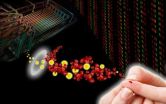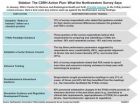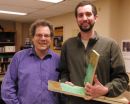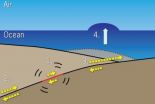(Press-News.org) PASADENA, Calif.—There's a wealth of health information hiding in the human immune system. Accessing it, however, can be very challenging, as the many and complex roles that the immune system plays can mask the critical information that is relevant to addressing specific health issues. Now, research led by scientists from the California Institute of Technology (Caltech) has shown that a new generation of microchips developed by the team can quickly and inexpensively assess immune function by examining biomarkers—proteins that can reflect the response of the immune system to disease—from single cells.
The scientists reported on their advanced technology in the May 22 online issue of Nature Medicine.
"The technology permits us for the first time to quantitatively measure the levels of many functional proteins from single, rare immune cells," says James Heath, the Elizabeth W. Gilloon Professor and professor of chemistry at Caltech and corresponding author of the study. "The functional proteins are the ones that are secreted by the cells, and they control biological processes such as cell replication and inflammation and, specific to our study, tumor killing."
In 2008, Heath—an expert in molecular electronics and personalized medicine—led the development of a "barcode chip" that, using just a pinprick's worth of blood, could measure the concentrations of dozens of proteins, including those that herald the presence of diseases like cancer and heart disease. This latest single-cell barcode chip (SCBC) device builds upon the success of that initial design, which is currently being utilized in diagnostic medical testing of certain cancer patients.
The researchers tested the chip by measuring a cancer patient's response to a type of cell-based immunotherapy designed to target and kill tumor cells. The only way to know if the therapy is doing its job is to measure many proteins at the same time from the individual cells that were targeting the tumor. The SCBC aced this test, generating readouts of a dozen secreted biomarkers—each of which represented a distinct cell function—and taking those readings from about a thousand single cells simultaneously.
The team was able to conduct a proof-of-concept study by looking at samples from a melanoma patient participating in the immunotherapy trials, and comparing those results to similar samples from three healthy subjects.
"This technology has the potential to be used routinely to monitor immune system performance," says Chao Ma, a graduate student in Heath's lab at Caltech's NanoSystems Biology Cancer Center and lead author of the Nature Medicine paper. "For example, it can be directly used to evaluate the effectiveness of certain classes of therapeutics, such as vaccines and other immunotherapies."
According to Ma, the technology is minimally invasive, cost-effective, and highly informative. The goal, he says, is to help physicians closely track the effectiveness of a therapy, and to rapidly alter or switch that therapy for the maximum benefit of the patient.
"The research fully demonstrates real-life clinical use of our revolutionary technology," Ma says.
The next step for the team will be to systematically apply the technology to clinical studies. The researchers have already begun to test the technology in additional patient populations, and to combine the SCBC with existing assays in order to get a more comprehensive picture of a therapy's efficacy.
In fact, the same study that showed the microchip's efficacy is already helping the researchers better evaluate the specific cancer immunotherapy trial, from which the patient in the study was drawn. "We are doing these same types of measurements on similar patients but at a significantly higher level of detail, and at many time points over the course of the cancer immunotherapy procedure," explains Heath. "It is helping us put together a 'movie' of the patient's immune system during the therapy, and it is providing us with some very surprising but also valuable insights into how the therapy works and how we might work with our UCLA colleagues to improve it."
"Application of this technology provides an unprecedented understanding of the human immune system by allowing an efficient and multiplexed functional readout of immune responses using limiting numbers of lymphocytes," says Antoni Ribas, associate professor of medicine and physician who led the clinical trial portion of the study at UCLA's Jonsson Comprehensive Cancer Center.
INFORMATION:
The other Caltech authors of the Nature Medicine paper, "A clinical microchip for evaluation of single immune cells reveals high functional heterogeneity in phenotypically similar T cells," are postdoctoral scholar Qihui Shi; Rong Fan, former postdoctoral scholar; former graduate students Habib Ahmad and Gabriel Kwong; and Chao-Chao Liu, former undergraduate student. Begonya Comin-Andiux, assistant professor of surgery; Thinle Chodon, assistant researcher of medicine; Richard C. Koya, assistant professor of surgery; and Caius G. Radu, associate professor of medical and molecular pharmacology from UCLA's Jonsson Comprehensive Cancer Center also contributed to the study.
The work was funded by the National Cancer Institute, the Ivy Foundation, the Jean Perkins Foundation, the California Institute for Regenerative Medicine, the Caltech/UCLA Joint Center for Translational Medicine, the Melanoma Research Alliance, and the National Institutes of Health.
Improving health assessments with a single cell
Caltech researchers develop quick, low-cost, and portable microchip for immune monitoring and clinical applications
2011-05-24
ELSE PRESS RELEASES FROM THIS DATE:
Universe's not-so-missing mass
2011-05-24
A Monash student has made a breakthrough in the field of astrophysics, discovering what has until now been described as the Universe's 'missing mass'. Amelia Fraser-McKelvie, working within a team at the Monash School of Physics, conducted a targeted X-ray search for the matter and within just three months found it – or at least some of it.
What makes the discovery all the more noteworthy is the fact that Ms Fraser-McKelvie is not a career researcher, or even studying at a postgraduate level. She is a 22-year-old undergraduate Aerospace Engineering/Science student who ...
Better scheduling of admissions can reduce crowding at children's hospitals
2011-05-24
Too many admissions at a hospital at one time can put patients at risk. A new study published today in the Journal of Hospital Medicine suggests that "smoothing" occupancy over the course of a week could help hospitals reduce crowding and protect patients from crowded conditions. The strategy involves controlling the entry of patients, when possible, to achieve more even levels of occupancy instead of the peaks and troughs that are commonly encountered.
Researchers gathered inpatient information from 39 children's hospitals during 2007, using it to compare weekday versus ...
FDA predictability a top concern for medtech firms; EU preferred for product approval
2011-05-24
WASHINGTON, DC––MAY 24, 2011––Two-thirds of small medical device and diagnostic companies––the drivers of innovation in the sector––are obtaining clearance for new products in Europe first, suggesting delayed market entry in the U.S., according to a comprehensive industrywide survey about FDA's 510(k) product review process by researchers at Northwestern University.
Large and small companies reported that unclear guidelines, inconsistent implementation, and lead reviewer turnover are contributing to increasing unpredictability of the process. Only 8% of survey respondents ...
Happy guys finish last, says new study on sexual attractiveness
2011-05-24
Women find happy guys significantly less sexually attractive than swaggering or brooding men, according to a new University of British Columbia study that helps to explain the enduring allure of "bad boys" and other iconic gender types.
The study – which may cause men to smile less on dates, and inspire online daters to update their profile photos – finds dramatic gender differences in how men and women rank the sexual attractiveness of non-verbal expressions of commonly displayed emotions, including happiness, pride, and shame.
Very few studies have explored the relationship ...
New study finds that violence doesn't add to children's enjoyment of TV shows, movies
2011-05-24
BLOOMINGTON, Ind. -- Despite growing concern about the effects of media violence on children, violent television shows and movies continue to be produced and marketed to them. An Indiana University research study concludes that violence doesn't add anything to their enjoyment of such programs and their characters.
In a research study published in the journal Media Psychology, Andrew J. Weaver, an assistant professor of telecommunications in IU's College of Arts and Sciences, and colleagues tested a common view presented by media producers that children like to watch violent ...
UT Southwestern researchers find protein breakdown contributes to pelvic organ prolapse
2011-05-24
DALLAS – May 24, 2011 – A gynecologist and a molecular biologist at UT Southwestern Medical Center have collaborated to show for the first time that pelvic organ prolapse – a condition in which the uterus, bladder or vagina protrude from the body – is caused by a combination of a loss of elasticity and a breakdown of proteins in the vaginal wall.
Pelvic organ prolapse affects many women older than 50 years of age. Besides creating pelvic pressure, prolapse can lead to other pelvic-floor disorders such as urinary and fecal incontinence, and can affect sexual function.
"We ...
WSU physicists devise new way to analyze a bloody crime scene
2011-05-24
PULLMAN, Wash.—Don't get him wrong: Fred Gittes is, in his words, "extremely squeamish."
But then a scientist with forensics training told him that crime scene investigators could use a better way to analyze blood spatters. The physicist in Gittes rose to the challenge.
"It seems as though what was being done was very crude from a physics point of view and that intrigued me," he says.
Along with Chris Varney, a doctoral candidate in physics, Gittes has worked out a system that can often determine exactly where blood spatters originate, a critical piece of evidence in ...
Unusual earthquake gave Japan tsunami extra punch, say Stanford scientists
2011-05-24
The magnitude 9 earthquake and resulting tsunami that struck Japan on March 11 were like a one-two punch – first violently shaking, then swamping the islands – causing tens of thousands of deaths and hundreds of billions of dollars in damage. Now Stanford researchers have discovered the catastrophe was caused by a sequence of unusual geologic events never before seen so clearly.
"It was not appreciated before this earthquake that this size of earthquake was possible on this plate boundary," said Stanford geophysicist Greg Beroza. "It was thought that typical earthquakes ...
Seeing an atomic thickness
2011-05-24
Scientists from the National Physical Laboratory (NPL), in collaboration with Linköping University, Sweden, have shown that regions of graphene of different thickness can be easily identified in ambient conditions using Electrostatic Force Microscopy (EFM).
The exciting properties of graphene are usually only applicable to the material that consists of one or two layers of the graphene sheets. Whilst synthesis of any number of layers is possible, the thicker layers have properties closer to the more common bulk graphite.
For device applications one- and two-layer graphene ...
Frequent moderate drinking of alcohol is associated with a lower risk of fatty liver disease
2011-05-24
In a large study of men in Japan, the presence of fatty liver disease by ultrasonography showed an inverse ( reduced risk) association with the frequency of moderate alcohol consumption; however, there was some suggestion of an increase in fatty liver disease with higher volume of alcohol consumed per day. Moderate drinkers had lower levels of obesity than did non-drinkers, and both obesity and metabolic abnormalities were positively associated with fatty liver disease.
These findings support the results of a number of other recent studies showing that moderate drinking ...
LAST 30 PRESS RELEASES:
Making lighter work of calculating fluid and heat flow
Normalizing blood sugar can halve heart attack risk
Lowering blood sugar cuts heart attack risk in people with prediabetes
Study links genetic variants to risk of blinding eye disease in premature infants
Non-opioid ‘pain sponge’ therapy halts cartilage degeneration and relieves chronic pain
AI can pick up cultural values by mimicking how kids learn
China’s ecological redlines offer fast track to 30 x 30 global conservation goal
Invisible indoor threats: emerging household contaminants and their growing risks to human health
Adding antibody treatment to chemo boosts outcomes for children with rare cancer
Germline pathogenic variants among women without a history of breast cancer
Tanning beds triple melanoma risk, potentially causing broad DNA damage
Unique bond identified as key to viral infection speed
Indoor tanning makes youthful skin much older on a genetic level
Mouse model sheds new light on the causes and potential solutions to human GI problems linked to muscular dystrophy
The Journal of Nuclear Medicine ahead-of-print tip sheet: December 12, 2025
Smarter tools for peering into the microscopic world
Applications open for funding to conduct research in the Kinsey Institute archives
Global measure underestimates the severity of food insecurity
Child survivors of critical illness are missing out on timely follow up care
Risk-based vs annual breast cancer screening / the WISDOM randomized clinical trial
University of Toronto launches Electric Vehicle Innovation Ontario to accelerate advanced EV technologies and build Canada’s innovation advantage
Early relapse predicts poor outcomes in aggressive blood cancer
American College of Lifestyle Medicine applauds two CMS models aligned with lifestyle medicine practice and reimbursement
Clinical trial finds cannabis use not a barrier to quitting nicotine vaping
Supplemental nutrition assistance program policies and food insecurity
Switching immune cells to “night mode” could limit damage after a heart attack, study suggests
URI-based Global RIghts Project report spotlights continued troubling trends in worldwide inhumane treatment
Neutrophils are less aggressive at night, explaining why nighttime heart attacks cause less damage than daytime events
Menopausal hormone therapy may not pose breast cancer risk for women with BRCA mutations
Mobile health tool may improve quality of life for adolescent and young adult breast cancer survivors
[Press-News.org] Improving health assessments with a single cellCaltech researchers develop quick, low-cost, and portable microchip for immune monitoring and clinical applications



